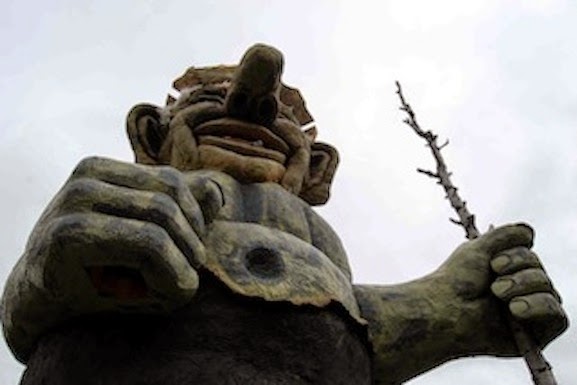Environmental historians speak
often of “reading the landscape.”
They see signs of glaciation from the rich soil of the upper Midwestern
United States to the rocky inlets along the fjords here in Norway. They note a tree that grew towards the
light, perhaps away from a wall or the shade of its neighbors. They note built paths that take them
through a park along approved routes and maverick paths that beeline towards a
swing set.
Rarely, however, do
environmental historians mean something so literal as reading words written on
the land, but that was one of the first and most intriguing sights that I
encountered in our new neighborhood in Oslo:
What struck me most was, first, that it was graffiti written
directly onto a rock wall and, second, that it was graffiti that was protected
and displayed as if it were in a museum – with a plastic cover and a wall
plaque:
The text reads in Norwegian: Ver Tro Mot H7 meaning: Be true
to King Haakon VII.
A little internet research (and, I confess, some possibly
questionable background knowledge culled from Joe Nesbø’s The Redbreast) revealed that the graffiti dates from World War II and
enjoined Norwegians to be faithful to the king during the Nazi occupation of
Norway.
Altogether, the graffiti and its preservation strike me as
distinctly Norwegian. Here, in a
round-about way, is why:
I commonly begin my environmental history class by
describing one of my favorite walks in Los Angeles’s Griffith Park. The walk used to take me past my own
potted, dwarf lemon tree and the manicured lawns of tony Los Feliz, across a
major street with four lanes of traffic, past a golf course, onto a hiking
trail, within sight of Griffith Park Observatory and the Hollywood sign, and
back home to my little lemon tree.
I ask my students to identify when I am closest to nature on the walk
and when I am farthest away. A
couple of years ago a student said that the view of the Hollywood sign took me
farthest from nature. “What’s a
better example of human culture defiling the landscape than writing a word on
the land itself?” he challenged.
“And what’s a better sign of the dregs of civilization than Hollywood?”
he continued.
Here in Norway, something like the Hollywood sign is indeed
hard to imagine. Reverence for
nature is a part of the Norwegian national character, perhaps best illustrated
in the concept of allemannsrett, translated as freedom to roam or everyman’s
right. Norwegians can hike, camp,
gather mushrooms, pick berries, assemble a bouquet, canoe and otherwise enjoy
the outdoors on almost any uncultivated land -- of which there’s a lot in
Norway. Yet, there’s no
tragedy of the commons here – the right relies on the assumption that
Norwegians will protect such spaces, and here’s what’s incredible to this
American: They do!
So valuable is nature to Norwegians that their rights depend
on its protection. Everyone has
freedom to roam so everyone better take care of where they’re roaming. Thus my
surprise at seeing graffiti on a rock wall. There’s a lot of graffiti in Oslo, but defiling a rock
wall, even in an urban park, seemed beyond the pale to me at first glance. But, of course, this was historical
graffiti, and apparently the H7 monogram was a common tag on buildings, fences
and other man-made structures during the war. What’s more Norwegian than to demand loyalty to Norway on a
piece of nature? Buildings and fences might not last. A rock, however, is likely to persevere. Norwegians will guarantee it.












